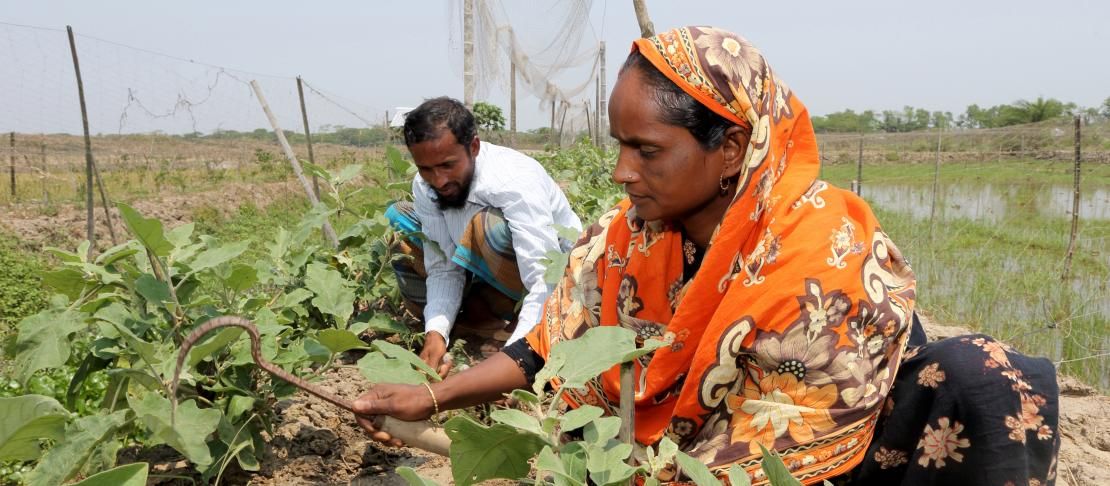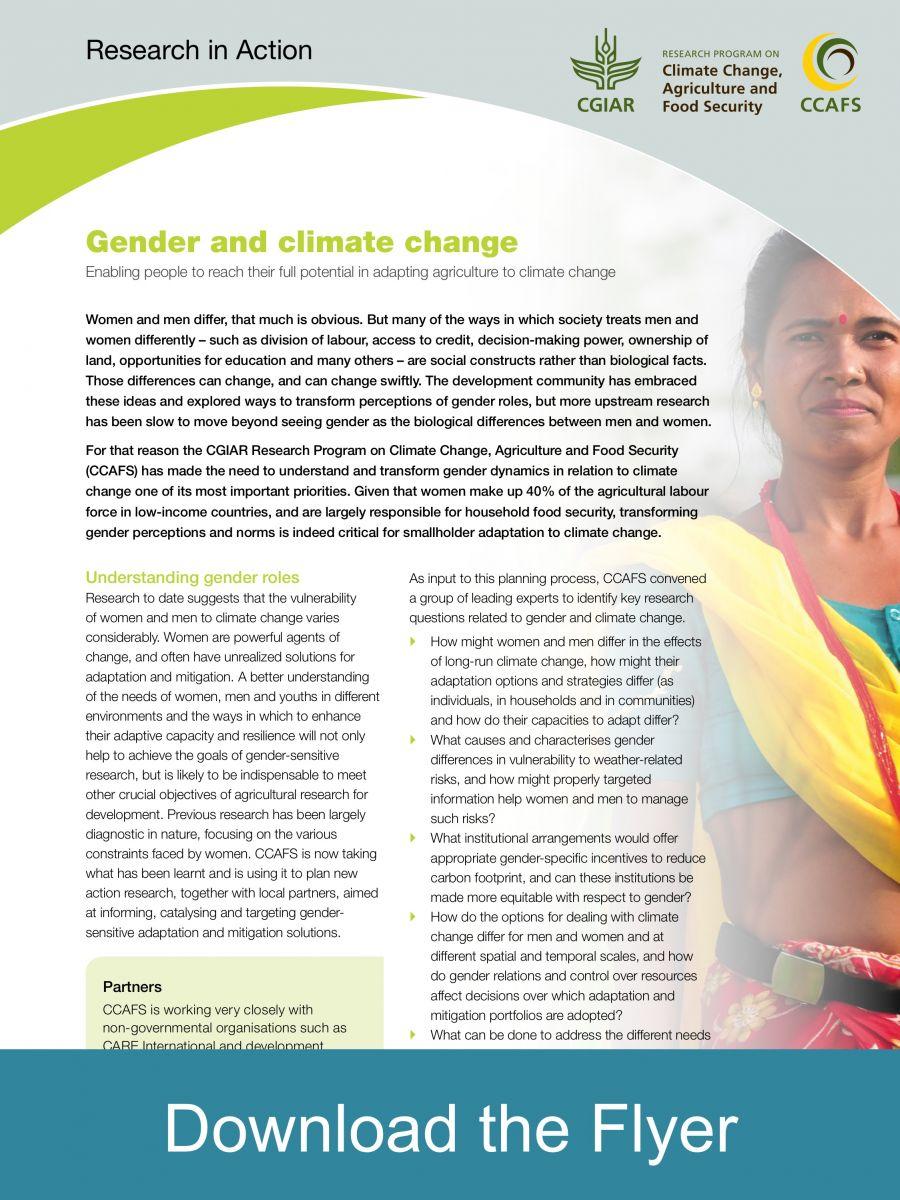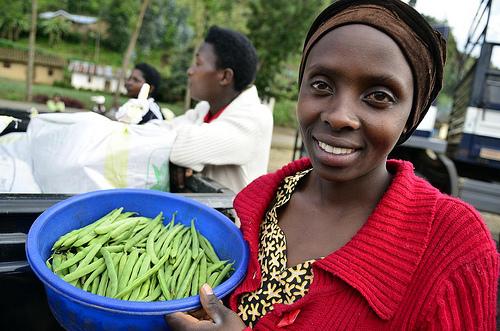Gender and climate change

Enabling people to reach their full potential in adapting agriculture to climate change
 Women and men differ, that much is obvious. But many of the ways in which society treats men and women differently – such as division of labour, access to credit, decision-making power, ownership of land, opportunities for education and many others – are social constructs rather than biological facts. Those differences can change, and can change swiftly. The development community has embraced these ideas and explored ways to transform perceptions of gender roles, but more upstream research has been slow to move beyond seeing gender as the biological differences between men and women.
Women and men differ, that much is obvious. But many of the ways in which society treats men and women differently – such as division of labour, access to credit, decision-making power, ownership of land, opportunities for education and many others – are social constructs rather than biological facts. Those differences can change, and can change swiftly. The development community has embraced these ideas and explored ways to transform perceptions of gender roles, but more upstream research has been slow to move beyond seeing gender as the biological differences between men and women.
For that reason the CGIAR Research Program on Climate Change, Agriculture and Food Security (CCAFS) has made the need to understand and transform gender dynamics in relation to climate change one of its most important priorities. Given that women make up 40% of the agricultural labour force in low-income countries, and are largely responsible for household food security, transforming gender perceptions and norms is indeed critical for smallholder adaptation to climate change.
Understanding gender roles
Research to date suggests that the vulnerability of women and men to climate change varies considerably. Women are powerful agents of change, and often have unrealized solutions for adaptation and mitigation. A better understanding of the needs of women, men and youths in different environments and the ways in which to enhance their adaptive capacity and resilience will not only help to achieve the goals of gender-sensitive research, but is likely to be indispensable to meet other crucial objectives of agricultural research for development. Previous research has been largely diagnostic in nature, focusing on the various constraints faced by women. CCAFS is now taking what has been learnt and is using it to plan new action research, together with local partners, aimed at informing, catalysing, and targeting gender-sensitive adaptation and mitigation solutions.
As input to this planning process, CCAFS convened a group of leading experts to identify key research questions related to gender and climate change.
- How might women and men differ in the effects of long-run climate change, how might their adaptation options and strategies differ (as individuals, in households and in communities) and how do their capacities to adapt differ?
- What causes and characterises gender differences in vulnerability to weather-related risks, and how might properly targeted information help women and men to manage such risks?
- What institutional arrangements would offer appropriate gender-specific incentives to reduce carbon footprint, and can these institutions be made more equitable with respect to gender?
- How do the options for dealing with climate change differ for men and women and at different spatial and temporal scales, and how do gender relations and control over resources affect decisions over which adaptation and mitigation portfolios are adopted?
- What can be done to address the different needs of women and men facing the challenges of climate change?
The first four sets of questions will help to fill evidence gaps in current and planned CCAFS research, while the fifth will encourage researchers to undertake gender-differentiated assessment of proposed solutions.
A sweet outcome for women:
High in the trees, stung by bees, harvesting honey in the Lower Nyando valley in Kenya is men's work: labour intensive and dangerous and not all that profitable. Average yields from the hollow logs that men use to attract wild bees are low, about 5 kg of honey per beehive per year, compared to the 90 kg that could potentially be achieved.
Women, however, have now become excellent beekeepers thanks to a partnership of Kenya's Ministry of Agriculture, World Neighbors, an international development organization, and farmer groups in the area. CCAFS and partners asked farmers in Lower Nyando which different activities might help them earn money, and thus make them more resilient if one crop should fail; the women mentioned beekeeping.
Researchers introduced improved beehives – at ground level – and trained women farmers to look after the bees and to process and market the honey and other products. The women also formed self-help groups affiliated to larger community-based organizations in order to promote learning and to empower each other. The women harvest the produce of the hives every three months. They share the proceeds among members of their group and reinvest in other activities, such as basket weaving. The result is improved livelihoods and resilience against climate change.
From theory to practice
The expert group identified a need for new gender-climate change focused research methods and capacity building in CCAFS target regions. A collaborative effort with FAO gender experts led to the development of training guidelines on Gender and Climate Change Research in Agriculture and Food Security for Rural Development. The CCAFS-FAO guide, recently translated into French and Spanish, contains practical advice for field researchers to help them document the differences among men and women and also explains why gender-sensitive approaches are so important for initiatives aimed at enhancing adaptive capacity to climate change.
Equipped with the guide and training in gender-sensitive participatory research methods, CCAFS collaborators (and others) are going into the field better prepared to thoughtfully and equitably engage both women and men. These approaches allow researchers and community members to reach a more nuanced understanding of the various adaptation and mitigation options that are best suited to the needs of different kinds of people facing a wide range of environmental and other changes.
Paying attention to gender, as the training guide suggests, can reveal surprising ways in which a minor change can help women. For example, during a CCAFS study in Kaffrine, Senegal, it emerged that while men like to get weather forecasts from rural radio stations, women prefer to receive the information through more personal contact. Forecasts on the radio continue, but in addition the local agricultural extension agent now brings information from meteorologists directly to local women farmers. Results show that farmers who took these forecasts into account – whether from the radio or from a personal contact – were better able to plan for the season ahead and increase their productivity.
if women had access to the same resources as men, we could increase agriculutral output in low-income countries by 2.5-4%
Research has shown that women often grow 20-30% less food than men for their efforts, the cumulative impact of all the ways in which societies treat women differently. If this gender gap were eliminated, the Food and Agriculture Organization of the UN (FAO) estimates that total agricultural output in low-income countries would increase by 2.5-4%, which could reduce the number of hungry people by 12-17%.
The need for a rapid and wholesale transformation of gender relationships is urgent. Biology is not destiny. That much ought to be obvious too.
Partners
CCAFS is working very closely with non-governmental organisations such as CARE International and development agencies such as the International Fund for Agricultural Development (IFAD) in order to ensure that the results of CCAFS gender-sensitive research feed through into development approaches that promote gender transformation.
Key Links and Resources
Download the flyer
Training Manual: The FAO and CCAFS training guidelines on Gender and Climate Change Research in Agriculture and Food Security for Rural Development
Policy Brief: Addressing gender in climate-smart smallholder agriculture
Working Paper: Participatory gender-sensitive approaches for addressing key climate change-related research issues
Working Paper: A gender strategy for pro-poor climate change mitigation
Working Paper: Investigating climate information services through a gendered lens
Workshop Report: CCAFS Gender Training and Strategizing Workshop Report
Blogs
New blogs highlighted during 2014 International Women's Day
Blog: What does 'taking a gender transformative approach' really mean?
Blog: How farmers' gender-based differences hamper climate change adapatation
Read all the latest blogs on gender here
GET GENDER IMPACT PATHWAYS for CCAFS regions
Presentation: Gender Impact Pathways for all CCAFS regions
CCAFS Gender Impact Pathway for Southeast Asia
CCAFS Gender Impact Pathway for South Asia
CCAFS Gender Impact Pathway for East Africa
CCAFS Gender Impact Pathway for West Africa
CCAFS Gender Impact Pathway for Latin America
